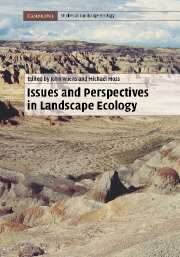Book contents
- Frontmatter
- Contents
- List of contributors
- Preface
- PART I Introductory perspectives
- PART II Theory, experiments, and models in landscape ecology
- PART III Landscape patterns
- PART IV Landscape dynamics on multiple scales
- PART V Applications of landscape ecology
- 18 Landscape ecology as the broker between information supply and management application
- 19 Farmlands for farming and nature
- 20 Landscape ecology and forest management
- 21 Landscape ecology and wildlife management
- 22 Restoration ecology and landscape ecology
- 23 Conservation planning at the landscape scale
- 24 Landscape conservation: a new paradigm for the conservation of biodiversity
- 25 The “why?” and the “so what?” of riverine landscapes
- PART VI Cultural perspectives and landscape planning
- PART VII Retrospect and prospect
- Index
- Plate section
- References
24 - Landscape conservation: a new paradigm for the conservation of biodiversity
from PART V - Applications of landscape ecology
Published online by Cambridge University Press: 20 November 2009
- Frontmatter
- Contents
- List of contributors
- Preface
- PART I Introductory perspectives
- PART II Theory, experiments, and models in landscape ecology
- PART III Landscape patterns
- PART IV Landscape dynamics on multiple scales
- PART V Applications of landscape ecology
- 18 Landscape ecology as the broker between information supply and management application
- 19 Farmlands for farming and nature
- 20 Landscape ecology and forest management
- 21 Landscape ecology and wildlife management
- 22 Restoration ecology and landscape ecology
- 23 Conservation planning at the landscape scale
- 24 Landscape conservation: a new paradigm for the conservation of biodiversity
- 25 The “why?” and the “so what?” of riverine landscapes
- PART VI Cultural perspectives and landscape planning
- PART VII Retrospect and prospect
- Index
- Plate section
- References
Summary
We are in the midst of one of the greatest ecological disasters ever to befall this planet. Species are vanishing worldwide at a rate rivaling the mass extinction events chronicled in the geological record, a rate which exceeds the “normal” or expected rate of extinction by several orders of magnitude (Wilson, 1988). Unlike previous mass extinctions, however, this one has been precipitated by a single species, Homo sapiens. It is no coincidence that the global biodiversity crisis occurs at a time when landscapes are being transformed at a rate unprecedented in human history. Humans have transformed up to 50% of the land surface on the planet, such that no landscape (or “aquascape”) remains untouched by the direct or indirect effects of human activities (Vitousek et al., 1997). Habitat destruction, in the form of outright loss, degradation, and fragmentation of habitat, is the leading cause of the current extinction crisis (Wilcove et al., 1998). Humans are the primary drivers of landscape change, and thus the current ecological crisis is really a cultural one (Naveh, 1995; Nassauer, this volume, Chapter 27). An understanding of the factors affecting land-use decisions, which involve cultural, political, and socioeconomic dimensions, must be integrated with the ecological consequences of landscape transformation if a full rendering of the biodiversity crisis is to be had and the crisis averted. This will require a holistic approach that transcends disciplines.
- Type
- Chapter
- Information
- Issues and Perspectives in Landscape Ecology , pp. 238 - 247Publisher: Cambridge University PressPrint publication year: 2005
References
- 5
- Cited by



